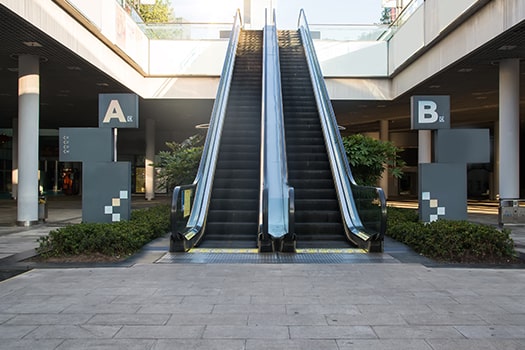Escalators are mechanical moving staircases designed to transport people between different levels of a building, such as from one floor to another in shopping malls, airports, train stations, and other public spaces. They provide a convenient and efficient means of vertical transportation, especially when dealing with large crowds or heavy foot traffic.

Continuous Movement:
Unlike elevators that move in discrete intervals, escalators offer a continuous stream of motion. This makes them well-suited for handling high volumes of people.
Inclined Design:
Escalators are typically designed with a slope, allowing people to move effortlessly between different levels. The angle of inclination depends on the intended use and the available space.
Steps and Handrails:
Escalators consist of a series of steps that move in a loop, providing a seamless transition from one step to the next. Handrails run alongside the steps to provide support and stability to passengers.
Directional Flow:
Escalators can be designed to move in a single direction or in a reversible manner, changing directions based on traffic patterns. Reversible escalators are particularly useful for managing traffic during peak hours.
Safety Features:
Escalators are equipped with various safety features, including sensors to detect obstructions and prevent entrapment, emergency stop buttons, and mechanical systems to halt the escalator if needed.
Maintenance:
Regular maintenance is crucial to ensure the smooth and safe operation of escalators. Moving parts, such as the steps and handrails, need proper upkeep to prevent wear and tear.
Capacity:
Escalators can handle a significant number of passengers per minute, making them efficient in moving large crowds.
Accessibility:
Many escalators are equipped with additional features, such as wider steps or a space for wheelchair users, to make them more accessible to people with disabilities.
Integration with Architecture:
Escalators are often integrated into the architectural design of a building, contributing to the overall aesthetic and flow of the space.
Commercial and Public Use:
Escalators are commonly found in shopping centers, transportation hubs, entertainment venues, and other public spaces where efficient vertical transportation is essential.
Energy Efficiency:
Modern escalators are designed with energy-efficient features, such as variable speed controls and sensors that adjust speed based on passenger traffic.
Safety and Regulations:
Escalators are subject to safety regulations and standards to ensure passenger well-being and prevent accidents.
Economic and Environmental Factors:
The installation and operation of escalators can have economic and environmental implications, as they consume energy and require ongoing maintenance.
